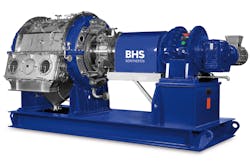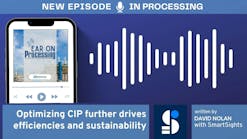The chemical processing of cellulose derivatives is carried out in the reactor under extremely high thermal and mechanical stress. Image courtesy of AVA GmbH u. Co. KG.
Cellulose derivatives bear many fascinating mechanical properties, which is why they have been used in a variety of industries since the middle of the 20th century. In the construction chemicals industry, for example, they are used to regulate the setting process, while in medicine, they are used in products such as eye drops. Their production involves multiple technological steps, spanning from the extraction of cellulose to homogenization of the end product.
When the French chemist Anselme Payen first extracted cellulose in 1838, he probably had little idea how important this substance would become. Today, the pharmaceuticals industry uses cellulose derivatives as thickeners or coating agents in different medicinal products, and they are added as stabilizers and emulsifying agents in ice cream and instant food products. These functional polymers offer useful mechanical properties — they prevent uncontrolled water release of binding agents and increase the viscosity of many products.
Several process steps are needed to manufacture derivatives such as methyl cellulose and hydroxypropyl methylcellulose. There are also specific challenges associated with each end product. "Requirements in the processing industry are as manifold as the products themselves," said Martin Specht, sales manager at AVA, a supplier of machines and system solutions in the areas of mixing and drying, reacting, evaporating, sterilizing and granulating. BHS acquired AVA in 2018.
Water-based derivatives — several process steps in one reactor
In contrast to derivatives like carboxymethyl cellulose, whose manufacturing is solvent-based, methyl cellulose production is water-based. Extracted from wood pulp or cotton linter, native cellulose with high purity — which is free from lignin and hemicellulose — is used as the raw material.
The chemical processing begins in the reactor. In the first step, sodium hydroxide is added to form alkali cellulose. This causes the fibers to swell, so that the hydroxy groups on the fibers are made accessible for the subsequent reactions. The alkaline pretreatment is important for the quantity and distribution of hydrophilic and hydrophobic substituents, and thus the mechanical properties of the resulting derivatives.
Highly efficient cake treatment with multistep solvent washes in the BHS-Sonthofen indexing belt filter. Image courtesy of BHS-Sonthofen GmbH.
"Both vertical and horizontal reactors can be used for this process in principle," explained Specht. "The homogeneity of the mixture is crucial in producing an optimal degree of alkalization. The mixers of the reactors are designed to achieve the best possible distribution with controlled cooling."
The second step — etherification with methyl chloride added for methyl cellulose or propylene oxide for hydroxypropyl methylcellulose — can take place in the same reactor. Exothermal reactions lead to evaporating of reagents and the pressure in the reactor may rise to approximately 20 bar. After the reaction, the pressure is released by means of external condensation, while solvents such as methyl chloride are recovered. The pulp-like product is then fully discharged and further processed in a stirring tank.
About the reactor design
The cleaned derivatives are granulated in the AVA ring layer mixer. Image courtesy of AVA GmbH u. Co. KG.
Special filtration requirements
A suspension which contains high quantities of sodium chloride and other undesired byproducts, alongside the desired derivatives, can now be found in the vessel. The reaction and neutralization processes thus follow multi-stage filtration and cleaning processes to separate these substances and achieve maximum product quality. The filtration process depends on the end product. A pressure process is suitable for water-based derivatives. Rotary pressure filters, which offer a wide range of benefits in comparison to the solid bowl centrifuges and screen centrifuges that were previously used, are often used for this procedure. The BHS rotary pressure filter has been successfully established since the 1980s.
"The separation of the derivatives from the salt is not an easy task from a technical perspective," said Detlef Steidl, senior director of sales filtration technology at BHS-Sonthofen. "The salt will be partially undissolved or trapped in the agglomerated product fibers. Good penetration by the washing agent, which is offered by the BHS rotary pressure filters of type RPF with its perfect piston flow, is essential in achieving sufficient washing for the highest requirements in product quality. At the same time, the washing agent quantity should be kept as low as possible, as water-based derivatives pose a risk of the product gelling."
Different cellulose derivatives are homogenized in the large-scale vertical mixer. Image courtesy of AVA GmbH u. Co. KG.
Rotary pressure filter prevents product losses and minimizes washing agent consumption
The rotary pressure filter allows cake treatment in several separate process steps. As this system features a highly compact design and the temperature can be set precisely, the temperature window no longer poses a challenge. The materials used for the system are also chloride-resistant. "After separation of the filtrate and filter cake, displacement washing occurs in several steps using the counterflow principle. This allows the salt to be efficiently removed from the filter cake without any considerable product loss and with low washing agent consumption," said Steidl.
The filter cake is then dehumidified in a blow-drying step. In the discharge zone, the cake is released into the non-pressurized atmosphere with a residual moisture of about 50-60%. A considerably lower residual moisture could be achieved mechanically, but this is not desired for subsequent granulation.
Formulation of the product
After filtration, the cleaned derivatives are formulated for industrial use.
"Both horizontal continuous mixers and AVA’s ring layer mixer are perfectly suited to cooling and granulating the product," said Specht. The ring layer mixer offers the advantage of higher mixing speeds. This increases the particle size during a short retention time of a few seconds for the subsequent process stages. A suitable granulation process gives rise to a product with a good particle shape and high apparent density, which is crucial for the subsequent formulation steps.
Then the product is shredded in several stages and dried to a moisture of just over 10%. A typical process route consists of steps such as wet grinding, drying in a horizontal continuous dryer, dry grinding and protective screening. The grindability of the product greatly depends on the residual moisture. Optimal drying is especially crucial to obtain a product with high fineness.
About cellulose derivatives
The product has a certain viscosity depending on the formula, measured, for example, using a two percent solution. A customized product can be manufactured by mixing products with different viscosities. Several cellulose derivatives are collected in a vertical mixer and homogenized within a short mixing time using other additives. The user thus receives a consistently high batch quality. The entire process is challenging from a technical perspective. This is where a technological understanding of the entire process becomes essential.
Roland Schmid is the director of marketing & communications at BHS. He holds a degree in business administration and has been with BHS since 2010.
Thomas Boerboom is in marketing communications at AVA. He holds a degree in media communication and has been with AVA since 2015.
Q&A with Detlef Steidl, senior director of sales filtration technology at BHS-Sonthofen
A: In principle, cellulose derivatives typically absorb water quickly and lose it slowly by dissipating it at different speeds. However, its production is carried out in a watery environment. What’s challenging in solid-liquid separation is that the permissible minimum and maximum temperature limits are very close together.
Q: What are the advantages offered by technologies that BHS-Sonthofen develops?
A: The rotary pressure filter is ideally suited for the water-based process. It is a compact system, which means that it is easy to achieve a narrow temperature window. The rotary pressure filter also operates at small cake heights, continuously under overpressure, using full-displacement washing, which ensures very good washing effects. Washing agent consumption and product losses are kept considerably low.
Q: BHS-Sonthofen acquired AVA in April 2018. What does that mean when it comes to the production of cellulose derivatives?
A: The product portfolios of the two companies complement each another perfectly. We will be able to take on responsibility for the entire engineering process in the future. Furthermore, both companies consider their most important task to be developing the best solution for each specific case. For customers, this means fewer interfaces and optimally coordinated processes for the best possible result.






